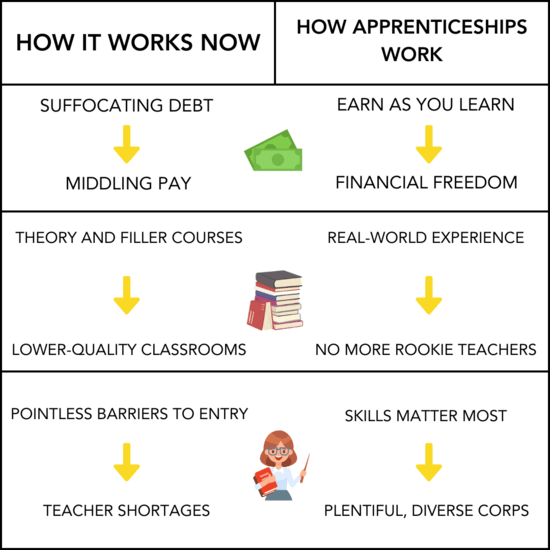This post originally appeared at https://reforminggovernment.org/policy-solution-teacher-apprenticeships-tackling-the-teacher-shortage/

Click here to find a print-ready version of the “Tackling the Teacher Shortage” policy solution.
We have a teacher shortage, but we did it to ourselves. College’s costs and complications encumber teachers with debt, don’t prepare them for actual classrooms, and keep the profession monolithic. This leads to worse outcomes for students, stress on our districts, and diminished economic output for our state. 16 states, from Tennessee and Texas to Michigan and California, have unlocked the future of teaching before we have: teacher apprenticeships. A 2+2 model with 2 years of lectures and a 2-year student teaching apprenticeship halves teachers’ tuitions, improves students’ results, and fills the teacher shortage with diverse, qualified educators. The apprenticeship model already works for high-status professions like doctors, IT staff, electricians, and artisans, and teaching can meet that same standard.
PROBLEM: TEACHER TRAINING IS COSTLY, OUTDATED, AND BAD FOR STUDENTS
Let’s face it: becoming a teacher doesn’t make sense. To start, you have to be one of the 19% of Wisconsin high schoolers who graduates from a 4-year college. You probably left $22,000 in debt, but your salary starts in the mid-30s and your benefits nosedive if you ever leave the state. Your primary path to a raise is dropping $45,000 more on a master’s degree, braving such courses as “Resilience and Self-Care” and “Coloniality of Language and Science in Education.” You got rocked your first year in the classroom because your college taught you wrong, and you’re close to quitting after just 1 year like 11% of Wisconsin teachers do. Even the softest hearts for students harden under this pressure.
Is it any wonder that Wisconsin can’t fill basic teaching jobs? Is it any surprise that Wisconsin students can’t crack the top 20 nationally in reading?
Teachers generate immense value for our state and propel kids to their once-distant dreams. It’s past time that we – all of us – give educators their due respect. Breaking down their financial stability and their pride in their work only serves the states taking our businesses and families.
But all we do for them now is subsidize system failure. Novice teachers hunker down in low-income schools just long enough to get their loans forgiven, giving the most challenging students the most ramshackle education. The colleges feasting on those loans can barely get half of their graduates to teach kids to read, leaving the FORT floppers with an unusable degree and creditor calls.
Finally, though, there is a better way. The teacher apprenticeship was born in 2022. It’s already making American schools better places to work and learn.
SOLUTION: APPRENTICESHIPS WORK FOR TEACHERS, TAXPAYERS, AND KIDS
In short, teacher apprenticeships make hands-on learning the focus of a teacher’s education. Typically, education majors take 3.5 years of lectures, including general education requirements that don’t help them become great educators, then get a 1-semester crash course in schools called “student teaching.” The autumn after graduation, those 22-year-olds are given 30 young lives to shape with little supervision. Students become the experiment and new teachers face daily crises of confidence.
Teacher apprenticeships treat education like the professional job it is by moving to a 2+2 model. College students cut their prerequisites, instead loading their first 2 years with the subject matter expertise and classroom management skills that they will need to thrive. Then, they earn college credit for up to 2 years of extended student teaching. This hands-on experience under a mentor teacher meets the federal definition of an apprenticeship, unlocking funding that can be used to pay apprentice teachers for their work or give mentor teachers bonuses. On top of that, apprentice teachers get classroom repetitions alongside quality coaching, maximizing their skill once they lead classrooms themselves. Furthermore, because this modern model prioritizes actual teaching skills over general knowledge, it knocks down traditional barriers to college. Districts will be able to hire people from their own backyards, thus diversifying the teacher corps, minimizing turnover, and saving immense recruitment time and money.
Kids win. Educators win. Schools win. Taxpayers win. If we get this right, every student could have a teacher in their prime, and our brightest lights would see teaching as a profession worth chasing.
ACTION: LEGISLATE THE FUTURE OF TEACHING
Teaching became a federally recognized apprenticeship industry in 2022, launched by the bipartisan coalition of Tennessee Governor Bill Lee, President Joe Biden, and their respective education and labor secretaries. Any state can add this path and receive financial support. To avoid legal challenges, Wisconsin should legislatively alter existing code on teacher education and apprenticeships that contradict the federal vision. Upon revision, Wisconsin could gain approval from the Wisconsin Apprenticeship Advisory Council and Professional Standards Council for Teachers, develop college-based programs, and apply for federal apprenticeship recognition.
- Amend Statute 118.19(3)(a) to ensure legislative authority over the definition of apprenticeships and of education majors’ general education requirements.
- Currently, DWD 295.15(2) requires an occupation to be “customarily learned in a practical way through a structured, systematic program of on-the-job supervised learning,” “clearly identified and commonly recognized throughout an industry,” “the progressive attainment of manual, mechanical, or technical skills and knowledge,” and requiring “related instruction to supplement the on-the-job learning.” Those more accurately describe trades, not apprenticeships, so the legislature should define them more broadly.
- Currently, PI 34.018(3) requires “a general education program as part of a bachelor’s degree program or higher.” The legislature should add apprenticeship credits as an alternative to general education credits.
NEED TO KNOW MORE?

 The economics of teaching don’t work. Why would all but the most dead-set educators pay $84,008 for a degree that pays $60,453 on average? Wisconsin teachers start at only $38,000, and that’s in the 15th-ranked state for cost-of-living-adjusted teacher pay! That shallow teacher pool caps output for our students and our state. We’ve already tried decades of subsidies and loan forgiveness. Let’s attack costs instead and give every teacher peace of mind and a smaller college bill.
The economics of teaching don’t work. Why would all but the most dead-set educators pay $84,008 for a degree that pays $60,453 on average? Wisconsin teachers start at only $38,000, and that’s in the 15th-ranked state for cost-of-living-adjusted teacher pay! That shallow teacher pool caps output for our students and our state. We’ve already tried decades of subsidies and loan forgiveness. Let’s attack costs instead and give every teacher peace of mind and a smaller college bill.
16 states have already diminished teacher debt by moving to an apprenticeship model. Teachers pay 2 years of tuition as usual to train in their content areas and classroom skills. However, upperclassmen then join school districts to student teach for 2 years under a master teacher, just as tradesmen and doctors do. At worst, apprentice teachers avoid 2 years of tuition payments, but some states even arrange living stipends. States can unlock a bevy of public funding options through this model, and businesses and philanthropists alike prefer curtailing costs to bailouts. Unions are already on board. Even public university systems have seen that increased interest balances out enrollment.
The healthy Wisconsin we all want relies on productive classrooms led by formidable educators. Let’s help teachers earn as they learn to make the road there less daunting. Someone, anybody, explain why teachers must take prerequisites and general education courses. In this state, future chemistry teachers can’t graduate without an elective on Huldrych Zwingli or free silver, and those hopeful algebra educators had better pray that they can remember kingdom, phylum, class come test time. Yet, somehow, 46% of elementary-degree holders fail the mandatory reading instruction test that bars them from the classroom. We’re botching the basics to force-fit a model. On top of that, all research shows that teachers hit their primes in year 3. The first year is survival, the second is tinkering. But years of lectures are no preparation for pandemic-disrupted classrooms; 18% don’t make it to 3 years. Such great turnover means that your child has a 10% chance of getting a novice teacher. The detriment to your student is massive.
Someone, anybody, explain why teachers must take prerequisites and general education courses. In this state, future chemistry teachers can’t graduate without an elective on Huldrych Zwingli or free silver, and those hopeful algebra educators had better pray that they can remember kingdom, phylum, class come test time. Yet, somehow, 46% of elementary-degree holders fail the mandatory reading instruction test that bars them from the classroom. We’re botching the basics to force-fit a model. On top of that, all research shows that teachers hit their primes in year 3. The first year is survival, the second is tinkering. But years of lectures are no preparation for pandemic-disrupted classrooms; 18% don’t make it to 3 years. Such great turnover means that your child has a 10% chance of getting a novice teacher. The detriment to your student is massive.
Teachers are surgeons, not generalists, so let’s give them real-world experience to hone their art. High school apprenticeships count for credit, so college apprenticeships should, too. 2 years under teachers who’ve seen it all will help apprentices reach distant students far better than another essay on theory. Additionally, master teachers alongside apprentices will bestow all of the development of 2 classroom years without impairing children. No child would ever have a rookie teacher.
The real skills of teaching are getting crowded out by clutter. Let’s shift training to what actually matters for the classroom.  Wisconsin districts have 48,458 fewer students in 2023 than in 2010, but we can’t find the people to teach them. The teacher shortage is so grievous in Wisconsin that we’re giving out 1-year emergency licenses so special needs kids can learn from somebody. The barriers above have locked far too many out. Just check the demographics. 75% of teachers are women. 94% are White. Not many were low-income or have held a job besides teaching. We’re asking kids from River Falls to figure out Milwaukee on the fly, and we’re asking boys to become men without seeing many to emulate. It’s not just those threadbare stories, though. 25% of students in rural towns like Colby and Independence don’t speak English natively. It’s over 40% in Abbotsford and Arcadia, and even 21% in Green Bay. The gap between students and staff has caused havoc; 5% of those students are proficient in reading and 67% are below grade level. When we fail low-income kids, boys, or non-White children early on, we prevent them from becoming the very educators that could break the cycle for others.
Wisconsin districts have 48,458 fewer students in 2023 than in 2010, but we can’t find the people to teach them. The teacher shortage is so grievous in Wisconsin that we’re giving out 1-year emergency licenses so special needs kids can learn from somebody. The barriers above have locked far too many out. Just check the demographics. 75% of teachers are women. 94% are White. Not many were low-income or have held a job besides teaching. We’re asking kids from River Falls to figure out Milwaukee on the fly, and we’re asking boys to become men without seeing many to emulate. It’s not just those threadbare stories, though. 25% of students in rural towns like Colby and Independence don’t speak English natively. It’s over 40% in Abbotsford and Arcadia, and even 21% in Green Bay. The gap between students and staff has caused havoc; 5% of those students are proficient in reading and 67% are below grade level. When we fail low-income kids, boys, or non-White children early on, we prevent them from becoming the very educators that could break the cycle for others.
Prioritizing teaching skills over general knowledge will get our teacher workforce humming again. First, making this degree an affordable, attainable option will clear the pipeline for young adults from every income, gender, geography, and race. A high school chemistry grade will matter less than rapport with children and pedagogical savvy. Second, it allows support teachers and mid-career professionals to transition to the front of the classroom. Those pools are far more diverse than those who knew they’d be teachers at 18. Third, districts can recruit high schoolers through much more serious grow-your-own programs. Instead of blowing resources recruiting out of town, out of state, or beyond our borders, schools can hire from their own communities. All candidates will gain more responsibility as they demonstrate competency before they lead their own classes, so teacher quality will never be in question.
The current path takes us to 40-student classrooms in rural and urban schools. Teacher apprenticeships can help every community invest in its own future.